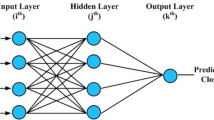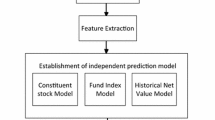Abstract
Based on the improved genetic algorithm and the BP neural network, the financial data analysis model is built on the basis of the data research problem in the financial industry, especially the stock market economy. Genetic algorithm (GA) is a bionic algorithm that simulates the evolutionary mechanism of “natural selection and survival of the fittest.” Through a suitable fitness function, it enables the high-quality individuals to inherit the next generation with a larger probability. Using this method to select variables, we can optimize the variables that affect the stock price and effectively solve the selection problem of the input layer variables of the neural network. On the basis of genetic algorithm, a new GA-BP model based on genetic algorithm and neural network is proposed, and it is applied to the prediction and analysis of securities price or trend in the securities intelligence analysis system. By selecting the Shanghai and Shenzhen 300 index data, the model based on genetic algorithm is used to carry out the experiment, and the experimental results show that the method can effectively reduce the number of variables while ensuring the accuracy of the prediction.





Similar content being viewed by others
References
Hilovska K, Koncz P (2012) Application of artificial intelligence and data mining techniques to financial markets. ACTA VSFS 6(1):62–76
Kumar PS, Anand D, Kumar VU et al (2016) A computational intelligence method for effective diagnosis of heart disease using genetic algorithm. Int J Bio-Sci Bio-Technol 8(2):363–372
Onieva E, Osaba E, Zhang X et al (2014) GABF: genetic algorithm with base fitness for obtaining generality from partial results: study in autonomous intersection by fuzzy logic. Appl Intell 41(1):1–12
Lee EH, Yang et al (2017) Research trends analysis of window ventilation system based on artificial intelligence. Kieae J 17(6):159–164
Yu W, Li S (2018) Research on financial data analysis based on data mining algorithm. Concurr Comput Pract Exp 1–10
Kim Y, Kim S (2015) A study on the optimal allocation for intelligence assets using MGIS and genetic algorithm. J Korean Inst Ind Eng 41(4):396–407
Wei H, Tang XS, Liu H (2015) A genetic algorithm(GA)-based method for the combinatorial optimization in contour formation. Appl Intell 43(1):112–131
Yu W, Li S, Tang X, et al. (2018) An efficient top-k ranking method for service selection based on ε-ADMOPSO algorithm. Neural Comput Appl 1–16. https://doi.org/10.1007/s00521-018-3640-9
Xu L, Liu H, Yan X et al (2015) Optimization method for trajectory combination in surveillance video synopsis based on genetic algorithm. J Ambient Intell Humaniz Comput 6(5):623–633
Oda T, Elmazi D, Barolli A et al (2016) A genetic algorithm-based system for wireless mesh networks: analysis of system data considering different routing protocols and architectures. Soft Comput 20(7):2627–2640
Ijaz S, Hashmi FA, Asghar S et al (2018) Vector Based Genetic algorithm to optimize predictive analysis in network security. Appl Intell 48(5):1086–1096
Li XY, Li XM, Li XW et al (2015) Cellular genetic algorithm based on chaotic map. Pattern Recognit Artif Intell 28(1):42–49
Mohammadi M, Azadeh A, Saberi M et al (2010) Genetic algorithm-based clustering ensemble: determination number of clusters. Int J Bus Forecast Marketing Intell 1(3/4):201–216
Yu W, Li S (2018) Recommender systems based on multiple social networks correlation. Future Gener Comput Syst 87:312–327
Acknowledgements
The authors acknowledge the National Natural Science Foundation of China (Grant: U1536114) and the National Natural Science Foundation of China (Grant: 61672393).
Author information
Authors and Affiliations
Corresponding author
Rights and permissions
About this article
Cite this article
Wang, X., Gan, L. & Liu, S. Research on intelligence analysis technology of financial industry data based on genetic algorithm. J Supercomput 76, 3391–3401 (2020). https://doi.org/10.1007/s11227-018-2584-2
Published:
Issue Date:
DOI: https://doi.org/10.1007/s11227-018-2584-2




